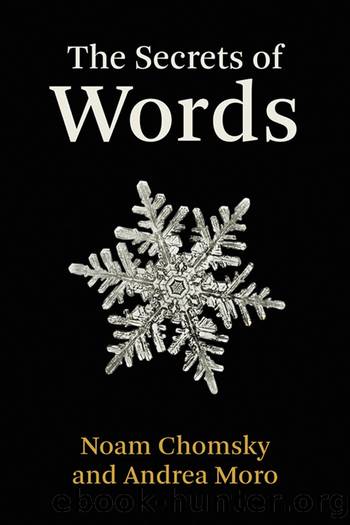The Secrets of Words by Noam Chomsky & Andrea Moro

Author:Noam Chomsky & Andrea Moro [Chomsky, Noam & Moro, Andrea]
Language: eng
Format: epub
Publisher: MIT Press
Published: 2022-04-12T00:00:00+00:00
NC Predicting the future of scientific inquiry is venturing into uncharted waters, perhaps even a foolâs errand. Maybe some great new ideas will come along, surprising us all. But keeping to what we now more or less understand, some challenging possibilities come to mind.
One is extending the neurolinguistic paradigm you developed to new areas. Structure-dependence, a fundamental property with far-reaching consequences, is well established on conceptual and empirical grounds, now extended to neurolinguistics. There are other claimants to a similar status. You brought up locality constraints, found in many areas. Presumably they have a common origin, perhaps in some notion of minimal search. Looking further, restriction of search holds outside of locality, as recent investigations have shown. And restriction of search in the domain of displacement you considered, the major area of inquiry into its application, raises the question why displacement takes place at allânot just displacement but also automatic âreconstruction,â the fact that in such sentences as âwhat did John seeâ we understand âwhatâ as the object of âsee.â Are there neural correlates that could shed some light on these very live topics?
As soon as the questions are raised, numerous others immediately come to mind. For example, could neurolinguistics inquiry shed light on the many questions that arise about in situ constructions with similar interpretations and properties but no displacement (or partial displacement), or about the residues left by successive-cyclic displacement?
The deeper question of why displacement takes place brings up the topic of dynamic antisymmetry that youâve explored in depth, in particular, as a factor motivating displacement. Here too many questions arise. Why are such structures âunstable,â requiring displacement? How does this factor in displacement interact with other considerations that have been proposed, among them Vergnaudâs abstract case theory and identification of categories (labeling)? Could some of the many dilemmas that arise be illuminated by neurolinguistic inquiry?
Until recently, the ubiquitous property of displacement-reconstruction was regarded as a problematic complexity of natural language, contrasting with the expected operation of joining two elements togetherâoften forming instability that has to be overcome by displacement. We now have good reason to believe that the opposite is true, for reasons related to the minimal search condition that figures prominently in locality. The considerations that arise are much like those you brought up in connection with parameters and Prague-distinctive features of phonology. And in science generally, as it pursues the objectives captured in Perrinâs pithy phrase that you quoted. Why, for example, are there these chemical elements, not others, and what are the hidden components of which they are constituted?
Throughout, could neurolinguistic inquiries be designed to provide insights into the many puzzles that appear as soon as we try to move beyond description to genuine explanation?
These musings scarcely begin to trace even one strand of the intricacies of language. Puzzles and challenges abound, maybe even mysteries that are beyond our cognitive reach. Weâve traveled far from the days when there seemed to be answers to just about everything. A good sign.
The current situation reminds me
Download
This site does not store any files on its server. We only index and link to content provided by other sites. Please contact the content providers to delete copyright contents if any and email us, we'll remove relevant links or contents immediately.
The remains of the day by Kazuo Ishiguro(8814)
Tools of Titans by Timothy Ferriss(8211)
Giovanni's Room by James Baldwin(7188)
The Black Swan by Nassim Nicholas Taleb(7009)
Inner Engineering: A Yogi's Guide to Joy by Sadhguru(6722)
The Way of Zen by Alan W. Watts(6503)
Asking the Right Questions: A Guide to Critical Thinking by M. Neil Browne & Stuart M. Keeley(5629)
The Power of Now: A Guide to Spiritual Enlightenment by Eckhart Tolle(5603)
The Six Wives Of Henry VIII (WOMEN IN HISTORY) by Fraser Antonia(5394)
Astrophysics for People in a Hurry by Neil DeGrasse Tyson(5130)
Housekeeping by Marilynne Robinson(4328)
12 Rules for Life by Jordan B. Peterson(4249)
Double Down (Diary of a Wimpy Kid Book 11) by Jeff Kinney(4204)
The Ethical Slut by Janet W. Hardy(4172)
Skin in the Game by Nassim Nicholas Taleb(4161)
Ikigai by Héctor García & Francesc Miralles(4123)
The Art of Happiness by The Dalai Lama(4063)
Skin in the Game: Hidden Asymmetries in Daily Life by Nassim Nicholas Taleb(3929)
Walking by Henry David Thoreau(3892)
